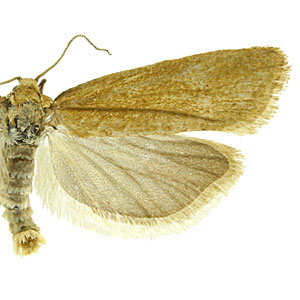Adult Recognition

FWL: 7.5-10.8 mm
Cnephasia longana is sexually dimorphic: males are a uniform white to yellowish brown while females are variably marked with light to dark brown. Some females have a strong fasciate pattern. Males lack a forewing costal fold.
The yellowish, narrow, elongate forewings separate this species from most of the other Tortricidae covered here. Other Palearctic Cnephasia, such as C. gueneeana, are similar, and a genitalic dissection can be used to confirm identity.
Larval Morphology

Late instar larvae are greenish brown or yellowish green with pale lateral lines and are approximately 14-18 mm in length. The head is pale brown with dark brown margins and the prothoracic shield is concolorous with the rest of the body.
Biology

Adults are present from late March to early July in North America.
Females lay eggs singly or in small batches in depressions or cracks in the bark of trees and cover them with bits of debris. After hatching, first instar larvae search out suitable cracks or crevices in bark, construct a silk hibernaculum, and hibernate for the remainder of the summer and following winter. Larvae leave the hibernaculum in the spring and disperse to nearby herbaceous plants by ballooning with the aid of silk threads. After encountering a suitable host, larvae mine within leaves close to the ground. Later instars web terminal parts of the plant, including the shoots, buds, and/or flowers. In some instances larvae may bore into fruit (such as strawberries) causing economic damage.
Host plants
Cnephasia longana larvae have been recorded feeding on a large number of herbaceous plants. In Europe, the larvae can be a pest of cereal crops. In Oregon and Washington, C. longana larvae have been reported as a pest of strawberries. The following host list contains plants in more than 20 families.
| Family | Genus/species | Common name |
| Apiaceae | Selinum carvifolium Crantz | |
| Asteraceae | Achillea L. | yarrow |
| Asteraceae | Achillea millefolium L. | common yarrow |
| Asteraceae | Agoseris heterophylla (Nutt.) Greene | annual agoseris |
| Asteraceae | Anthemis cotula L. | stinking chamomile |
| Asteraceae | Anthemis L. | chamomile |
| Asteraceae | Aster L. | aster |
| Asteraceae | Centaurea L. | knapweed |
| Asteraceae | Chrysanthemum L. | daisy |
| Asteraceae | Cirsium Mill. | thistle |
| Asteraceae | Erigeron glaucus Ker Gawl. | seaside fleabane |
| Asteraceae | Hypochaeris L. | cat's ear |
| Asteraceae | Leucanthemum vulgare Lam. | oxeye daisy |
| Asteraceae | Ligularia Cass. | summer ragwort |
| Asteraceae | Senecio jacobaea L. | stinking willie |
| Asteraceae | Sonchus arvensis L. | field sowthistle |
| Asteraceae | Tripolium pannonicum (Jacq.) Dobrocz. | sea aster |
| Asteraceae | Wyethia angustifolia (DC.) Nutt. | California compassplant |
| Berberidaceae | Mahonia pinnata (Lag.) Fedde | wavyleaf barberry |
| Boraginaceae | Amsinckia Lehm. | fiddleneck |
| Boraginaceae | Amsinckia menziesii (Lehm.) A. Nelson & J.F. Macbr. var. intermedia (Fisch. & C.A. Mey.) Ganders | common fiddleneck |
| Caryophyllaceae | Lychnis L. | campion |
| Convolvulaceae | Convolvulus L. | bindweed |
| Crassulaceae | Sempervivum tectorum L. | common houseleek |
| Fabaceae | Lupinus albifrons Benth. | silver lupine |
| Fabaceae | Lupinus L. | lupine |
| Fabaceae | Psoralea L. | |
| Fabaceae | Vicia americana Muhl. ex Willd. | American vetch |
| Fabaceae | Vicia L. | vetch |
| Geraniaceae | Erodium cicutarium (L.) L'Her. ex Aiton | redstem stork's bill |
| Geraniaceae | Geranium L. | geranium |
| Hydrophyllaceae | Phacelia distans Benth. | distant phacelia |
| Lamiaceae | Stachys L. | hedgenettle |
| Linaceae | Linum L. | flax |
| Onagraceae | Camissonia Link | suncup |
| Papaveraceae | Eschscholzia californica Cham. | California poppy |
| Plantaginaceae | Plantago lanceolata L. | narrowleaf plantain |
| Plumbaginaceae | Armeria maritima (Mill.) Willd. | thrift seapink |
| Polygonaceae | Eriogonum latifolium Sm. | seaside buckwheat |
| Polygonaceae | Eriogonum Michx. | buckwheat |
| Polygonaceae | Rumex acetosella L. | common sheep sorrel |
| Polygonaceae | Rumex L. | dock |
| Ranunculaceae | Ranunculus L. | buttercup |
| Rosaceae | Fragaria L. | strawberry |
| Rosaceae | Prunus armeniaca L. | apricot |
| Scrophulariaceae | Castilleja Mutis ex L. f. | Indian paintbrush |
| Scrophulariaceae | Collinsia multicolor Lindl. & Paxton | San Francisco blue eyed Mary |
| Scrophulariaceae | Scrophularia californica Cham. & Schltdl. | California figwort |
| Violaceae | Viola L. | violet |
| Zygophyllaceae | Fagonia L. | fagonbush |
Distribution

Cnephasia longana is native to the Palearctic where it is widely distributed across Europe, northwestern Africa, and Asia. It was introduced into western North America in the late 1920's, where it is currently present in southern British Columbia, Washington, Oregon, and California.
References

Bradley, J. D., W. G. Tremewan and A. Smith. 1973. British tortricoid moths, Cochylidae and Tortricidae: Tortricinae. The Ray Society, London. 259 pp.
Crop Protection Compendium. 2007 Edition. CAB International, Wallingford, UK, 2007.
Glas, M. 1991. Tortricids in cereals, pp. 553-661. In: L. P. S. van der Geest, H. H. Evenhuis (eds.), Tortricid pests, their biology, natural enemies and control. Elsevier, Amsterdam, The Netherlands.
Powell, J. A. 1964. Biological and taxonomic studies on tortricine moths, with reference to the species in California. University of California Publications in Entomology. Vol. 32. 317 pp.
Powell, J. A. and P. A. Opler. 2009. Moths of western North America. University of California Press, Berkeley. 369 pp.







